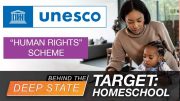
President Trump signed an executive order on Monday that will expand school choice options for in-person classes during the pandemic, the Washington Times reports.
The order provides “emergency learning scholarships” through the Community Services Block Grant program under the Health and Human Services Department to cover tuition and fees for any child who does not have access to in-person learning. The grants may be used for private or parochial schools, homeschooling, “microschools,” and learning pods, as well as for special education and associated services such as therapy and tutoring.
As noted by the Washington Times, community service block grants totaled nearly $1.7 billion in 2020, but the executive order does not specify how much of that money will be made available for scholarships and how much each family is entitled to receive.
The order notes how the federal government spent more than $13 billion this year to help states and districts reopen for in-person instruction, but in spite of that, “more than 50 percent of all public-school students in the United States began school remotely this fall.”
According to the executive order, the continued school closures are having a devastating impact on students:
The prolonged deprivation of in-person learning opportunities has produced undeniably dire consequences for the children of this country. The Centers for Disease Control and Prevention has stated that school attendance is negatively correlated with a child’s risk of depression and various types of abuse. States have seen substantial declines in reports of child maltreatment while school buildings have been closed, indicating that allegations are going unreported. These reductions are driven in part by social isolation from the schoolteachers and support staff with whom students typically interact and who have an obligation to report suspected child maltreatment. The American Academy of Pediatrics (AAP) has also found that school closures have a “substantial impact on food security and physical activity for children and families.” Additionally, a recent survey of educators found student absences from school, including virtual learning, have nearly doubled during the pandemic, and as AAP has noted, chronic absenteeism is associated with alcohol and drug use, teenage pregnancy, juvenile delinquency, and suicide attempts.
Students are also struggling academically as a result of the school closures, with a disproportionately negative impact on low-income and minority students.
“In low-income zip codes, students’ math progress decreased by nearly 50 percent while school buildings were closed in the spring, and the math progress of students in middle-income zip codes fell by almost a third during the same period,” the order states. “A recent analysis projected that, if in-person classes do not fully resume until January 2021, Hispanic, Black, and low-income students will lose 9.2, 10.3, and 12.4 months of learning, respectively.”
The closures also strike a financial blow to families, particularly dual-income households.
“In 2019, more than 90 percent of children under the age of 18 had at least one employed parent,” the executive order states. “Many employed parents do not have the option of engaging in remote work that allows them the flexibility to supervise their children during the day when in-person learning options are not available. Without the resumption of in-person learning opportunities, the economic and social harms resulting from such lost employment opportunities will continue to compound.”
The executive order goes on to say that the closures have also devastated private schools, many of which have been forced to close as a result of the pandemic and resultant shutdowns.
Meanwhile, Politico reports a recent study from UNICEF found “no consistent link between reopening schools and increased rates of coronavirus infection.”
“Schools are not a main driver of community transmission, and children are more likely to get the virus outside of school settings,” UNICEF said.
In fact, the worldwide study found that “there is strong evidence that, with basic safety measures in place, the net benefits of keeping schools open outweigh the costs of closing them.”
“While children can get sick and can spread the disease, this is just the tip of the pandemic iceberg,” said Henrietta Fore, UNICEF executive director. “Disruptions to key services and soaring poverty rates pose the biggest threat to children. The longer the crisis persists, the deeper its impact on children’s education, health, nutrition and well-being. The future of an entire generation is at risk.”
But even as data continues to prove that schools are not the superspreaders fearmongers claimed they would be, and while schools in Europe have remained open in spite of spikes in coronavirus cases, schools across the United States have remained closed.





